Financial Health Assessment: A Report on State Trading Org. PLC
VerifiedAdded on 2023/06/10
|14
|4581
|183
Report
AI Summary
This report provides a comprehensive financial analysis of State Trading Organization PLC, focusing on its financial performance and position. It examines various long-term funding sources, including equity shares, preference shares, debentures, bank borrowings, and retained earnings, noting that 80% of the company's long-term capital is raised from equity. Despite this, the debt ratio and debt-equity ratio indicate exposure to financial risk. The analysis of financial leverage reveals that a significant portion of the capital is raised through debt, with a financial leverage of 2.07 suggesting high leverage and risk. While the company consistently pays dividends, profitability ratios show a decreasing trend. The report also touches upon dividend policies and provides insights for potential investors, recommending a cautious approach due to the identified financial risks.
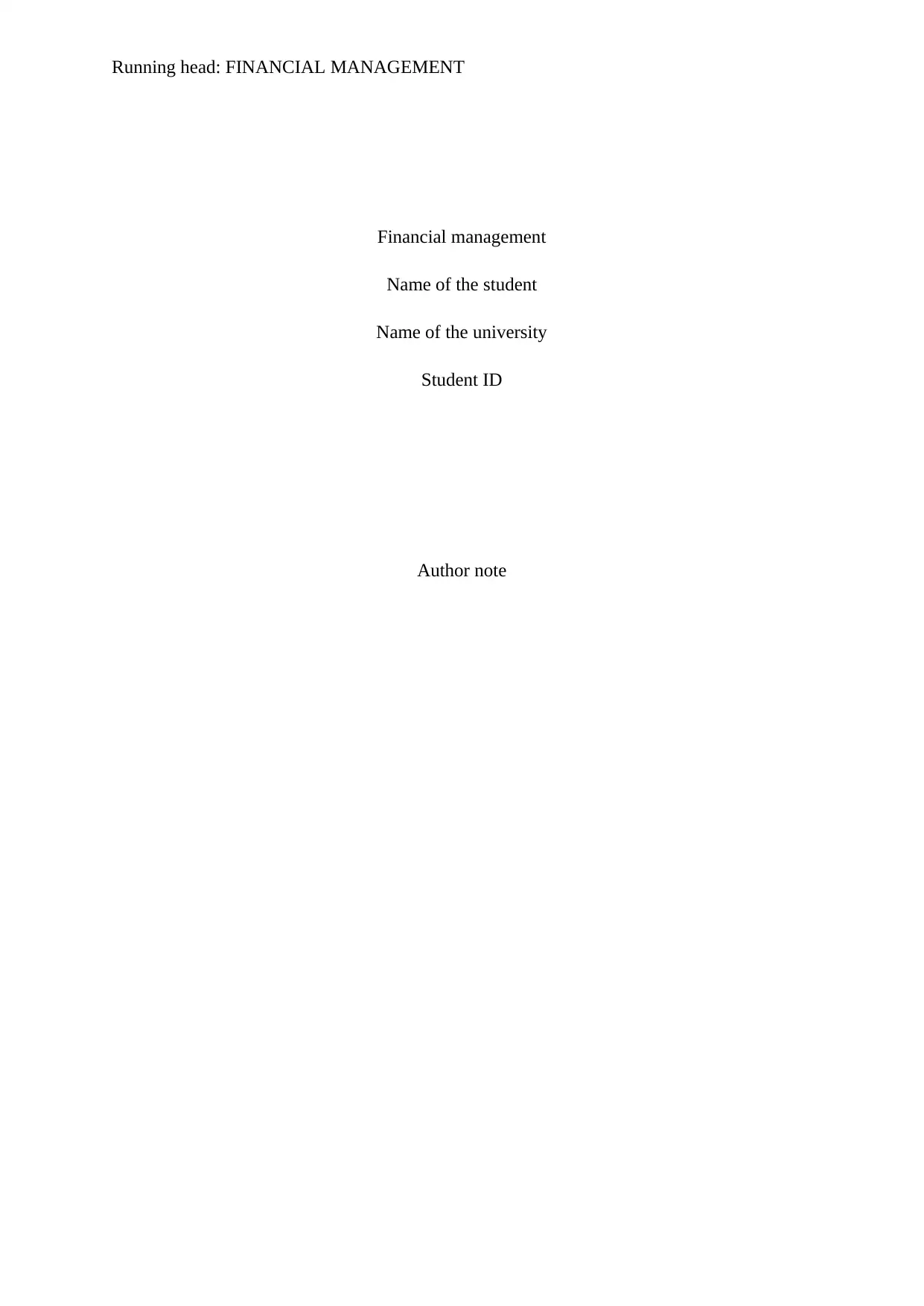
Running head: FINANCIAL MANAGEMENT
Financial management
Name of the student
Name of the university
Student ID
Author note
Financial management
Name of the student
Name of the university
Student ID
Author note
Paraphrase This Document
Need a fresh take? Get an instant paraphrase of this document with our AI Paraphraser
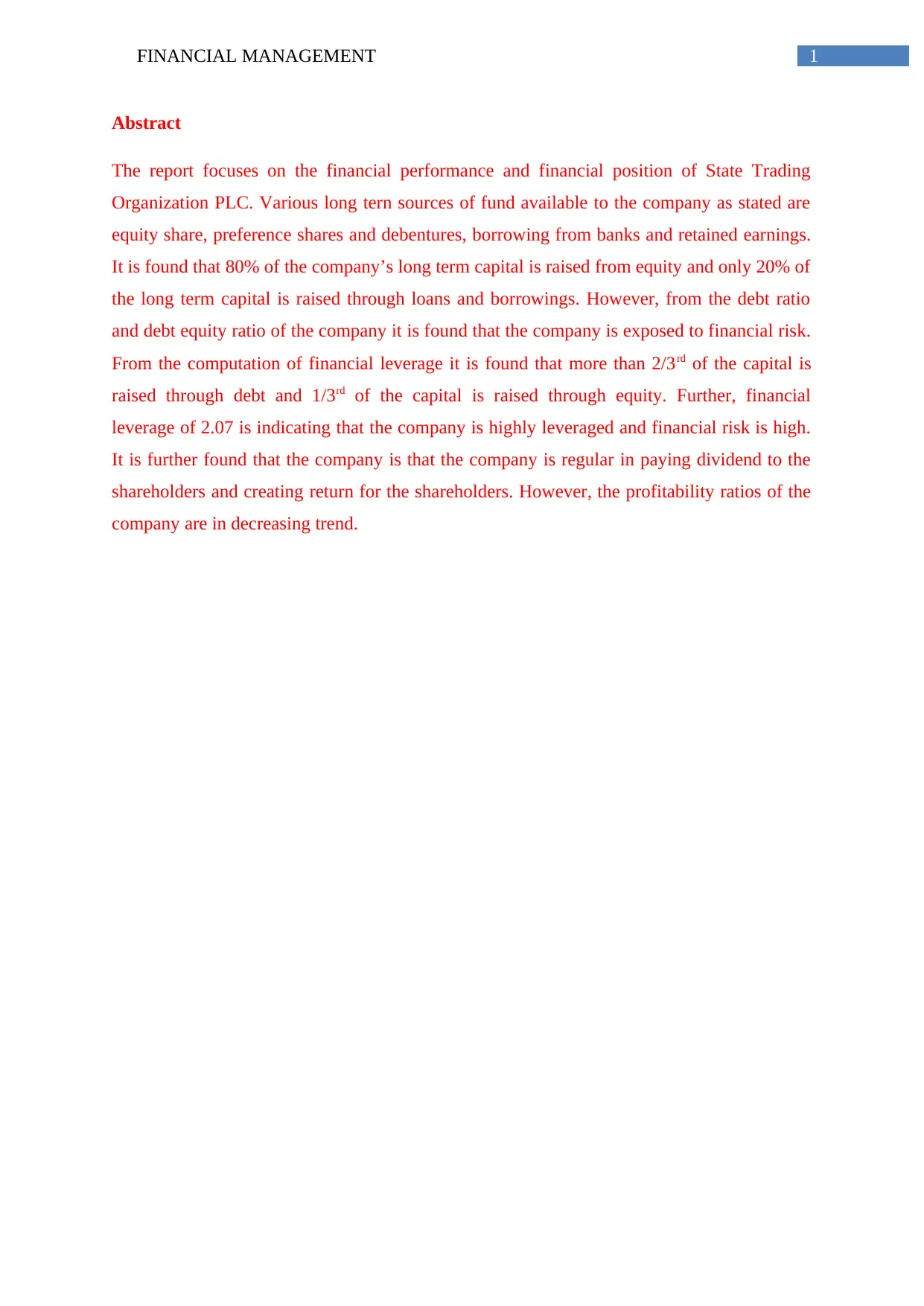
1FINANCIAL MANAGEMENT
Abstract
The report focuses on the financial performance and financial position of State Trading
Organization PLC. Various long tern sources of fund available to the company as stated are
equity share, preference shares and debentures, borrowing from banks and retained earnings.
It is found that 80% of the company’s long term capital is raised from equity and only 20% of
the long term capital is raised through loans and borrowings. However, from the debt ratio
and debt equity ratio of the company it is found that the company is exposed to financial risk.
From the computation of financial leverage it is found that more than 2/3rd of the capital is
raised through debt and 1/3rd of the capital is raised through equity. Further, financial
leverage of 2.07 is indicating that the company is highly leveraged and financial risk is high.
It is further found that the company is that the company is regular in paying dividend to the
shareholders and creating return for the shareholders. However, the profitability ratios of the
company are in decreasing trend.
Abstract
The report focuses on the financial performance and financial position of State Trading
Organization PLC. Various long tern sources of fund available to the company as stated are
equity share, preference shares and debentures, borrowing from banks and retained earnings.
It is found that 80% of the company’s long term capital is raised from equity and only 20% of
the long term capital is raised through loans and borrowings. However, from the debt ratio
and debt equity ratio of the company it is found that the company is exposed to financial risk.
From the computation of financial leverage it is found that more than 2/3rd of the capital is
raised through debt and 1/3rd of the capital is raised through equity. Further, financial
leverage of 2.07 is indicating that the company is highly leveraged and financial risk is high.
It is further found that the company is that the company is regular in paying dividend to the
shareholders and creating return for the shareholders. However, the profitability ratios of the
company are in decreasing trend.

2FINANCIAL MANAGEMENT
Table of Contents
Introduction................................................................................................................................2
Availability of long-term finance...............................................................................................2
Long-term source of capital...................................................................................................2
Long-term capital structure of the company..........................................................................3
Optimum capital structure......................................................................................................4
Risk attitude...........................................................................................................................4
Leverage of the company...........................................................................................................5
Operating leverage.................................................................................................................5
Financial leverage..................................................................................................................6
Implications of findings for the investor................................................................................6
Dividend policies available to the company..............................................................................7
Dividend policy of State Trading Organization PLC.............................................................8
Profitability of the company and profitability trend..................................................................9
Conclusion and recommendation.............................................................................................10
Reference..................................................................................................................................11
Table of Contents
Introduction................................................................................................................................2
Availability of long-term finance...............................................................................................2
Long-term source of capital...................................................................................................2
Long-term capital structure of the company..........................................................................3
Optimum capital structure......................................................................................................4
Risk attitude...........................................................................................................................4
Leverage of the company...........................................................................................................5
Operating leverage.................................................................................................................5
Financial leverage..................................................................................................................6
Implications of findings for the investor................................................................................6
Dividend policies available to the company..............................................................................7
Dividend policy of State Trading Organization PLC.............................................................8
Profitability of the company and profitability trend..................................................................9
Conclusion and recommendation.............................................................................................10
Reference..................................................................................................................................11
⊘ This is a preview!⊘
Do you want full access?
Subscribe today to unlock all pages.

Trusted by 1+ million students worldwide
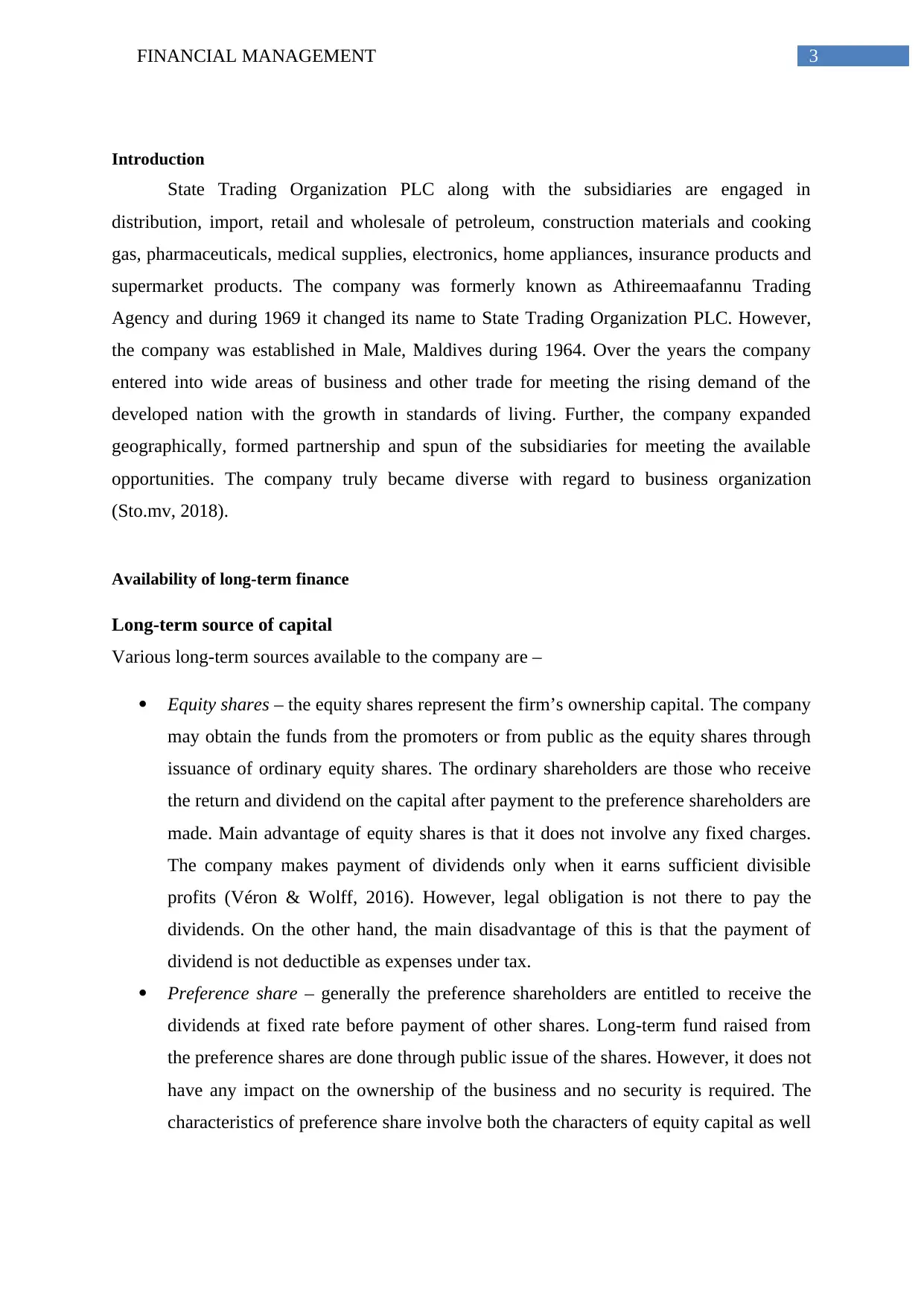
3FINANCIAL MANAGEMENT
Introduction
State Trading Organization PLC along with the subsidiaries are engaged in
distribution, import, retail and wholesale of petroleum, construction materials and cooking
gas, pharmaceuticals, medical supplies, electronics, home appliances, insurance products and
supermarket products. The company was formerly known as Athireemaafannu Trading
Agency and during 1969 it changed its name to State Trading Organization PLC. However,
the company was established in Male, Maldives during 1964. Over the years the company
entered into wide areas of business and other trade for meeting the rising demand of the
developed nation with the growth in standards of living. Further, the company expanded
geographically, formed partnership and spun of the subsidiaries for meeting the available
opportunities. The company truly became diverse with regard to business organization
(Sto.mv, 2018).
Availability of long-term finance
Long-term source of capital
Various long-term sources available to the company are –
Equity shares – the equity shares represent the firm’s ownership capital. The company
may obtain the funds from the promoters or from public as the equity shares through
issuance of ordinary equity shares. The ordinary shareholders are those who receive
the return and dividend on the capital after payment to the preference shareholders are
made. Main advantage of equity shares is that it does not involve any fixed charges.
The company makes payment of dividends only when it earns sufficient divisible
profits (Véron & Wolff, 2016). However, legal obligation is not there to pay the
dividends. On the other hand, the main disadvantage of this is that the payment of
dividend is not deductible as expenses under tax.
Preference share – generally the preference shareholders are entitled to receive the
dividends at fixed rate before payment of other shares. Long-term fund raised from
the preference shares are done through public issue of the shares. However, it does not
have any impact on the ownership of the business and no security is required. The
characteristics of preference share involve both the characters of equity capital as well
Introduction
State Trading Organization PLC along with the subsidiaries are engaged in
distribution, import, retail and wholesale of petroleum, construction materials and cooking
gas, pharmaceuticals, medical supplies, electronics, home appliances, insurance products and
supermarket products. The company was formerly known as Athireemaafannu Trading
Agency and during 1969 it changed its name to State Trading Organization PLC. However,
the company was established in Male, Maldives during 1964. Over the years the company
entered into wide areas of business and other trade for meeting the rising demand of the
developed nation with the growth in standards of living. Further, the company expanded
geographically, formed partnership and spun of the subsidiaries for meeting the available
opportunities. The company truly became diverse with regard to business organization
(Sto.mv, 2018).
Availability of long-term finance
Long-term source of capital
Various long-term sources available to the company are –
Equity shares – the equity shares represent the firm’s ownership capital. The company
may obtain the funds from the promoters or from public as the equity shares through
issuance of ordinary equity shares. The ordinary shareholders are those who receive
the return and dividend on the capital after payment to the preference shareholders are
made. Main advantage of equity shares is that it does not involve any fixed charges.
The company makes payment of dividends only when it earns sufficient divisible
profits (Véron & Wolff, 2016). However, legal obligation is not there to pay the
dividends. On the other hand, the main disadvantage of this is that the payment of
dividend is not deductible as expenses under tax.
Preference share – generally the preference shareholders are entitled to receive the
dividends at fixed rate before payment of other shares. Long-term fund raised from
the preference shares are done through public issue of the shares. However, it does not
have any impact on the ownership of the business and no security is required. The
characteristics of preference share involve both the characters of equity capital as well
Paraphrase This Document
Need a fresh take? Get an instant paraphrase of this document with our AI Paraphraser
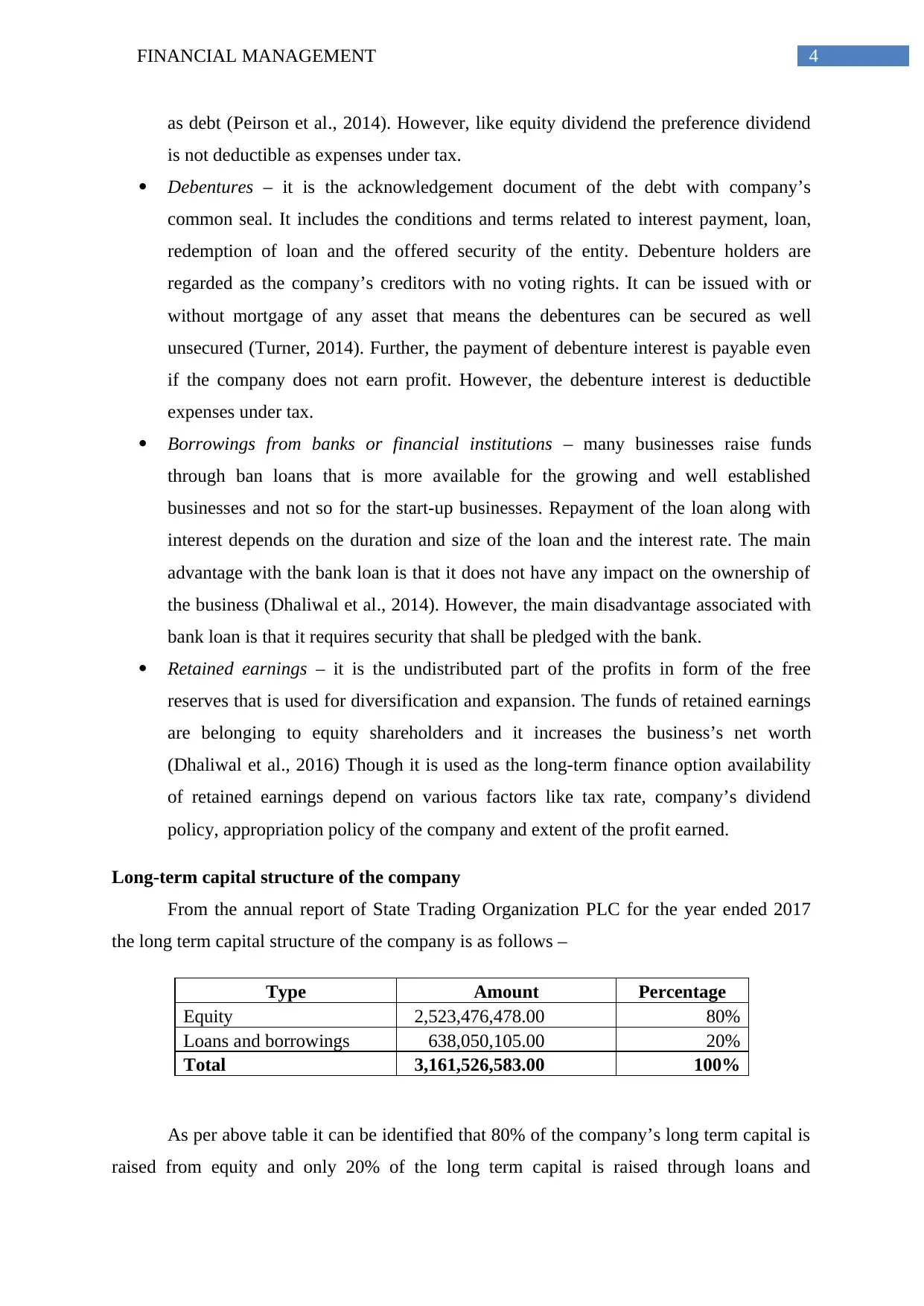
4FINANCIAL MANAGEMENT
as debt (Peirson et al., 2014). However, like equity dividend the preference dividend
is not deductible as expenses under tax.
Debentures – it is the acknowledgement document of the debt with company’s
common seal. It includes the conditions and terms related to interest payment, loan,
redemption of loan and the offered security of the entity. Debenture holders are
regarded as the company’s creditors with no voting rights. It can be issued with or
without mortgage of any asset that means the debentures can be secured as well
unsecured (Turner, 2014). Further, the payment of debenture interest is payable even
if the company does not earn profit. However, the debenture interest is deductible
expenses under tax.
Borrowings from banks or financial institutions – many businesses raise funds
through ban loans that is more available for the growing and well established
businesses and not so for the start-up businesses. Repayment of the loan along with
interest depends on the duration and size of the loan and the interest rate. The main
advantage with the bank loan is that it does not have any impact on the ownership of
the business (Dhaliwal et al., 2014). However, the main disadvantage associated with
bank loan is that it requires security that shall be pledged with the bank.
Retained earnings – it is the undistributed part of the profits in form of the free
reserves that is used for diversification and expansion. The funds of retained earnings
are belonging to equity shareholders and it increases the business’s net worth
(Dhaliwal et al., 2016) Though it is used as the long-term finance option availability
of retained earnings depend on various factors like tax rate, company’s dividend
policy, appropriation policy of the company and extent of the profit earned.
Long-term capital structure of the company
From the annual report of State Trading Organization PLC for the year ended 2017
the long term capital structure of the company is as follows –
Type Amount Percentage
Equity 2,523,476,478.00 80%
Loans and borrowings 638,050,105.00 20%
Total 3,161,526,583.00 100%
As per above table it can be identified that 80% of the company’s long term capital is
raised from equity and only 20% of the long term capital is raised through loans and
as debt (Peirson et al., 2014). However, like equity dividend the preference dividend
is not deductible as expenses under tax.
Debentures – it is the acknowledgement document of the debt with company’s
common seal. It includes the conditions and terms related to interest payment, loan,
redemption of loan and the offered security of the entity. Debenture holders are
regarded as the company’s creditors with no voting rights. It can be issued with or
without mortgage of any asset that means the debentures can be secured as well
unsecured (Turner, 2014). Further, the payment of debenture interest is payable even
if the company does not earn profit. However, the debenture interest is deductible
expenses under tax.
Borrowings from banks or financial institutions – many businesses raise funds
through ban loans that is more available for the growing and well established
businesses and not so for the start-up businesses. Repayment of the loan along with
interest depends on the duration and size of the loan and the interest rate. The main
advantage with the bank loan is that it does not have any impact on the ownership of
the business (Dhaliwal et al., 2014). However, the main disadvantage associated with
bank loan is that it requires security that shall be pledged with the bank.
Retained earnings – it is the undistributed part of the profits in form of the free
reserves that is used for diversification and expansion. The funds of retained earnings
are belonging to equity shareholders and it increases the business’s net worth
(Dhaliwal et al., 2016) Though it is used as the long-term finance option availability
of retained earnings depend on various factors like tax rate, company’s dividend
policy, appropriation policy of the company and extent of the profit earned.
Long-term capital structure of the company
From the annual report of State Trading Organization PLC for the year ended 2017
the long term capital structure of the company is as follows –
Type Amount Percentage
Equity 2,523,476,478.00 80%
Loans and borrowings 638,050,105.00 20%
Total 3,161,526,583.00 100%
As per above table it can be identified that 80% of the company’s long term capital is
raised from equity and only 20% of the long term capital is raised through loans and

5FINANCIAL MANAGEMENT
borrowings. Rate of interest on borrowing made from various sources ranged from 5% to
9.75% and payment schedule is made till the year 2028. On the other hand, the equity
involves share capital, general reserves and retained earnings (Sto.mv, 2018).
Optimum capital structure
The optimal capital structure is the financial measurement that is used by the
company for determining best mix of the equity and debt for using in the expansion and
operation of the business. The structure lower the capital cost so that the company is less
dependent on the creditors and able to finance majorly through equity (Barton & Wiseman,
2014). Company’s capital structure can be computed through using the following ratios –
Ratio Formula 2017
Debt ratio Total liabilities / total assets 0.67
Debt equity ratio Total liabilities / total equity 2.07
Interest coverage ratio Operating profit / interest expenses 2.29
Debt ratio – it is the financial ratio used to measure the leverage extent of the company. It
measures the total debt used by the company to obtain the assets and is expressed in
percentage or decimal. From the above calculation it can be recognized that the debt ratio of
the company is 0.67 which will be considered as high (Checherita-Westphal, Hughes Hallett
& Rother, 2014).
Debt equity ratio – it states the percentage of debt and equity used by the company to finance
the assets and extent to which the equity of the shareholders can meet the creditor’s
obligation in case the business declines (Heikal, Khaddafi & Ummah, 2014). As per the
calculation the debt equity ratio of the company is 2.07 that indicate that more than 2/3rd of
the capital is raised through debt and 1/3rd of the capital is raised through equity.
Interest coverage ratio – it measures the ability of the company with regard to payment of
outstanding debt. Generally, interest coverage ratio of 2 or more is considered good and
indicates that the company is able to meet its debt obligation. The interest coverage ratio for
State Trading Organization PLC of 2.29 is indicating that the company is able to meet its debt
obligation.
Risk attitude
If the debt ratio is considered, from the perspective of pure risk 0.4 or lower debt ratio
is considered as better debt ratio. As the interest payment on debt is to be made irrespective
borrowings. Rate of interest on borrowing made from various sources ranged from 5% to
9.75% and payment schedule is made till the year 2028. On the other hand, the equity
involves share capital, general reserves and retained earnings (Sto.mv, 2018).
Optimum capital structure
The optimal capital structure is the financial measurement that is used by the
company for determining best mix of the equity and debt for using in the expansion and
operation of the business. The structure lower the capital cost so that the company is less
dependent on the creditors and able to finance majorly through equity (Barton & Wiseman,
2014). Company’s capital structure can be computed through using the following ratios –
Ratio Formula 2017
Debt ratio Total liabilities / total assets 0.67
Debt equity ratio Total liabilities / total equity 2.07
Interest coverage ratio Operating profit / interest expenses 2.29
Debt ratio – it is the financial ratio used to measure the leverage extent of the company. It
measures the total debt used by the company to obtain the assets and is expressed in
percentage or decimal. From the above calculation it can be recognized that the debt ratio of
the company is 0.67 which will be considered as high (Checherita-Westphal, Hughes Hallett
& Rother, 2014).
Debt equity ratio – it states the percentage of debt and equity used by the company to finance
the assets and extent to which the equity of the shareholders can meet the creditor’s
obligation in case the business declines (Heikal, Khaddafi & Ummah, 2014). As per the
calculation the debt equity ratio of the company is 2.07 that indicate that more than 2/3rd of
the capital is raised through debt and 1/3rd of the capital is raised through equity.
Interest coverage ratio – it measures the ability of the company with regard to payment of
outstanding debt. Generally, interest coverage ratio of 2 or more is considered good and
indicates that the company is able to meet its debt obligation. The interest coverage ratio for
State Trading Organization PLC of 2.29 is indicating that the company is able to meet its debt
obligation.
Risk attitude
If the debt ratio is considered, from the perspective of pure risk 0.4 or lower debt ratio
is considered as better debt ratio. As the interest payment on debt is to be made irrespective
⊘ This is a preview!⊘
Do you want full access?
Subscribe today to unlock all pages.

Trusted by 1+ million students worldwide

6FINANCIAL MANAGEMENT
of the profitability status of the company higher debt ratio like 0.6 or more will expose the
company to operational risk. Further, the debt equity ratio of 2.07 is indicating that the
company is highly leveraged and financial risk is high (Lebedeva et al., 2016).
Leverage of the company
The term leverage refers to borrowing or debt availed by the company for financing
the purchase of its equipment, inventory and other assets. The company can obtain the fund
through equity or debt for financing or purchasing the assets of the company. Using the debt
or leverage will increase the bankruptcy risk of the company. However, it increases the
returns of the company particularly the return on the equity. Further, payment on debt it
deductible expenses under tax and the company can establish positive history for payment
through making payment of debt in timely manner (Jarrow, 2013). From the above
calculation it can be identified that 67% of the company’s capital is raised from debt and only
33% of the capital is raised through equity. Therefore, the company will be considered as
highly leveraged as higher proportion of asset is financed through debt.
Operating leverage
It measures the fixed asset of the company as compared to the percentage of total
assets. Operating leverage matrix is used for analysing the break-even point of the business
and estimated profit levels on sale. Below mentioned two scenarios states about low
operating leverage and high operating leverage –
High operating leverage – Generally, large portion of the cost of any company are involved
fixed cost and in such cases the company earns profit for each incremental sales. However the
company shall attain enough sales volume for covering up the substantial fixed cost. If the
company can do so then it may earn high level of profit on the entire sales after paying off for
fixed cost (Kahl, Lunn & Nilsson, 2014).
Low operating leverage - large portion of the sales are considered as variable cost and
therefore the variable costs are incurred only when the sales take place. In such scenario the
entity earns smaller amount of profit on each level of incremental sales. However, the
company is not required to generate high level of sales for covering up lower amount of fixed
cost. Therefore it is easier for this kind of entity to generate the profit at lower level of sales.
However the company is not able to earn high level of profits even when it generates
additional sales.
of the profitability status of the company higher debt ratio like 0.6 or more will expose the
company to operational risk. Further, the debt equity ratio of 2.07 is indicating that the
company is highly leveraged and financial risk is high (Lebedeva et al., 2016).
Leverage of the company
The term leverage refers to borrowing or debt availed by the company for financing
the purchase of its equipment, inventory and other assets. The company can obtain the fund
through equity or debt for financing or purchasing the assets of the company. Using the debt
or leverage will increase the bankruptcy risk of the company. However, it increases the
returns of the company particularly the return on the equity. Further, payment on debt it
deductible expenses under tax and the company can establish positive history for payment
through making payment of debt in timely manner (Jarrow, 2013). From the above
calculation it can be identified that 67% of the company’s capital is raised from debt and only
33% of the capital is raised through equity. Therefore, the company will be considered as
highly leveraged as higher proportion of asset is financed through debt.
Operating leverage
It measures the fixed asset of the company as compared to the percentage of total
assets. Operating leverage matrix is used for analysing the break-even point of the business
and estimated profit levels on sale. Below mentioned two scenarios states about low
operating leverage and high operating leverage –
High operating leverage – Generally, large portion of the cost of any company are involved
fixed cost and in such cases the company earns profit for each incremental sales. However the
company shall attain enough sales volume for covering up the substantial fixed cost. If the
company can do so then it may earn high level of profit on the entire sales after paying off for
fixed cost (Kahl, Lunn & Nilsson, 2014).
Low operating leverage - large portion of the sales are considered as variable cost and
therefore the variable costs are incurred only when the sales take place. In such scenario the
entity earns smaller amount of profit on each level of incremental sales. However, the
company is not required to generate high level of sales for covering up lower amount of fixed
cost. Therefore it is easier for this kind of entity to generate the profit at lower level of sales.
However the company is not able to earn high level of profits even when it generates
additional sales.
Paraphrase This Document
Need a fresh take? Get an instant paraphrase of this document with our AI Paraphraser
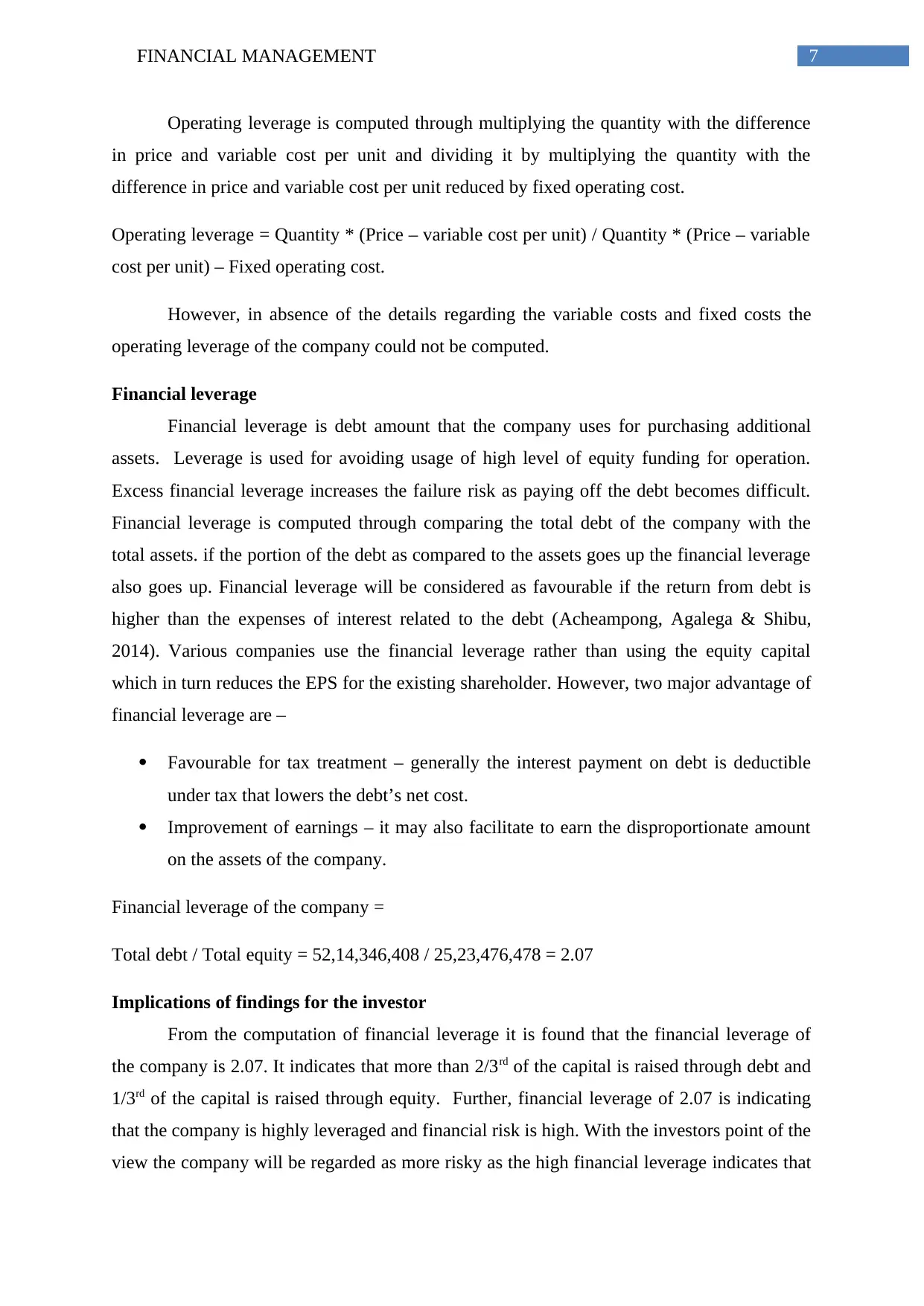
7FINANCIAL MANAGEMENT
Operating leverage is computed through multiplying the quantity with the difference
in price and variable cost per unit and dividing it by multiplying the quantity with the
difference in price and variable cost per unit reduced by fixed operating cost.
Operating leverage = Quantity * (Price – variable cost per unit) / Quantity * (Price – variable
cost per unit) – Fixed operating cost.
However, in absence of the details regarding the variable costs and fixed costs the
operating leverage of the company could not be computed.
Financial leverage
Financial leverage is debt amount that the company uses for purchasing additional
assets. Leverage is used for avoiding usage of high level of equity funding for operation.
Excess financial leverage increases the failure risk as paying off the debt becomes difficult.
Financial leverage is computed through comparing the total debt of the company with the
total assets. if the portion of the debt as compared to the assets goes up the financial leverage
also goes up. Financial leverage will be considered as favourable if the return from debt is
higher than the expenses of interest related to the debt (Acheampong, Agalega & Shibu,
2014). Various companies use the financial leverage rather than using the equity capital
which in turn reduces the EPS for the existing shareholder. However, two major advantage of
financial leverage are –
Favourable for tax treatment – generally the interest payment on debt is deductible
under tax that lowers the debt’s net cost.
Improvement of earnings – it may also facilitate to earn the disproportionate amount
on the assets of the company.
Financial leverage of the company =
Total debt / Total equity = 52,14,346,408 / 25,23,476,478 = 2.07
Implications of findings for the investor
From the computation of financial leverage it is found that the financial leverage of
the company is 2.07. It indicates that more than 2/3rd of the capital is raised through debt and
1/3rd of the capital is raised through equity. Further, financial leverage of 2.07 is indicating
that the company is highly leveraged and financial risk is high. With the investors point of the
view the company will be regarded as more risky as the high financial leverage indicates that
Operating leverage is computed through multiplying the quantity with the difference
in price and variable cost per unit and dividing it by multiplying the quantity with the
difference in price and variable cost per unit reduced by fixed operating cost.
Operating leverage = Quantity * (Price – variable cost per unit) / Quantity * (Price – variable
cost per unit) – Fixed operating cost.
However, in absence of the details regarding the variable costs and fixed costs the
operating leverage of the company could not be computed.
Financial leverage
Financial leverage is debt amount that the company uses for purchasing additional
assets. Leverage is used for avoiding usage of high level of equity funding for operation.
Excess financial leverage increases the failure risk as paying off the debt becomes difficult.
Financial leverage is computed through comparing the total debt of the company with the
total assets. if the portion of the debt as compared to the assets goes up the financial leverage
also goes up. Financial leverage will be considered as favourable if the return from debt is
higher than the expenses of interest related to the debt (Acheampong, Agalega & Shibu,
2014). Various companies use the financial leverage rather than using the equity capital
which in turn reduces the EPS for the existing shareholder. However, two major advantage of
financial leverage are –
Favourable for tax treatment – generally the interest payment on debt is deductible
under tax that lowers the debt’s net cost.
Improvement of earnings – it may also facilitate to earn the disproportionate amount
on the assets of the company.
Financial leverage of the company =
Total debt / Total equity = 52,14,346,408 / 25,23,476,478 = 2.07
Implications of findings for the investor
From the computation of financial leverage it is found that the financial leverage of
the company is 2.07. It indicates that more than 2/3rd of the capital is raised through debt and
1/3rd of the capital is raised through equity. Further, financial leverage of 2.07 is indicating
that the company is highly leveraged and financial risk is high. With the investors point of the
view the company will be regarded as more risky as the high financial leverage indicates that
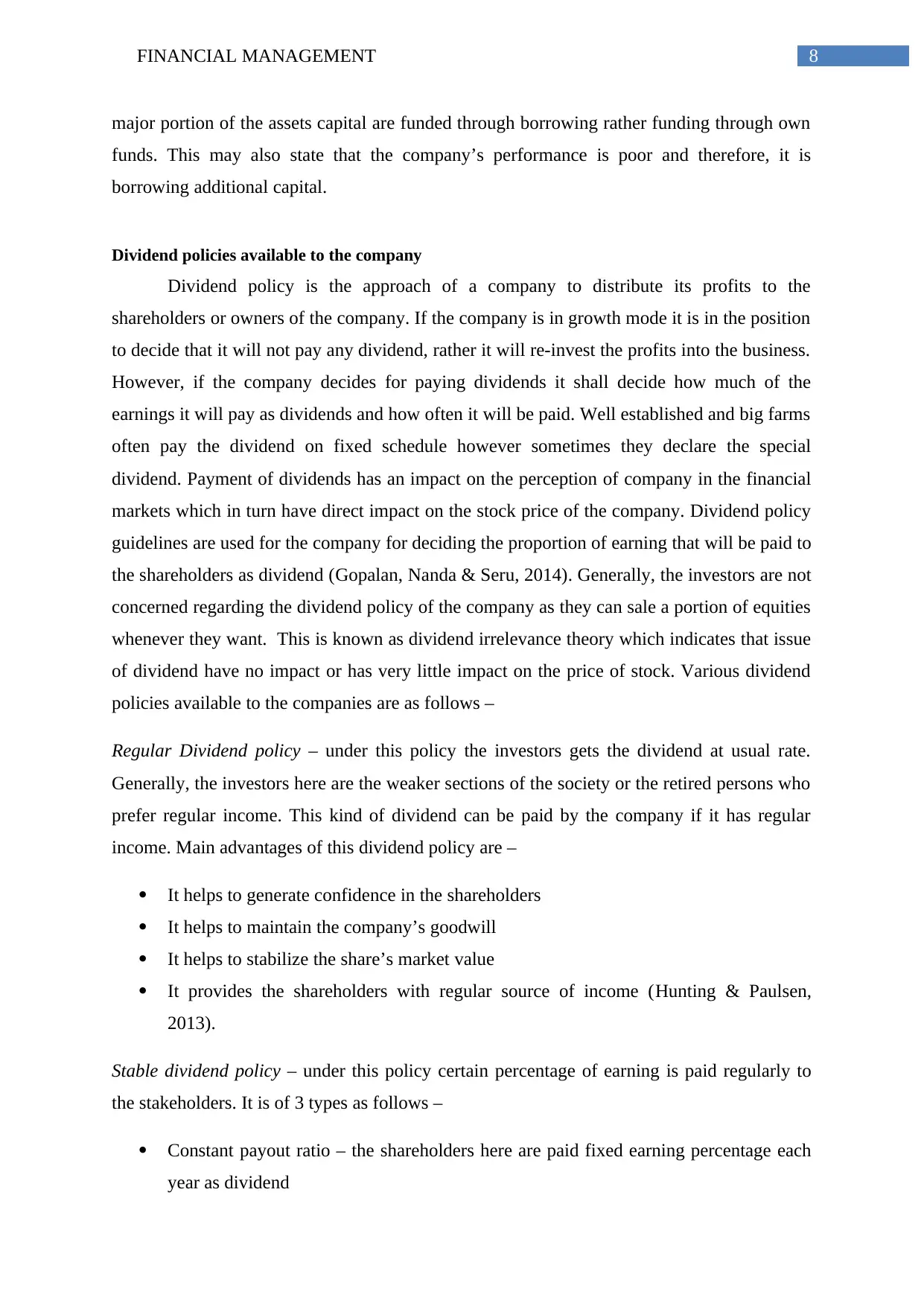
8FINANCIAL MANAGEMENT
major portion of the assets capital are funded through borrowing rather funding through own
funds. This may also state that the company’s performance is poor and therefore, it is
borrowing additional capital.
Dividend policies available to the company
Dividend policy is the approach of a company to distribute its profits to the
shareholders or owners of the company. If the company is in growth mode it is in the position
to decide that it will not pay any dividend, rather it will re-invest the profits into the business.
However, if the company decides for paying dividends it shall decide how much of the
earnings it will pay as dividends and how often it will be paid. Well established and big farms
often pay the dividend on fixed schedule however sometimes they declare the special
dividend. Payment of dividends has an impact on the perception of company in the financial
markets which in turn have direct impact on the stock price of the company. Dividend policy
guidelines are used for the company for deciding the proportion of earning that will be paid to
the shareholders as dividend (Gopalan, Nanda & Seru, 2014). Generally, the investors are not
concerned regarding the dividend policy of the company as they can sale a portion of equities
whenever they want. This is known as dividend irrelevance theory which indicates that issue
of dividend have no impact or has very little impact on the price of stock. Various dividend
policies available to the companies are as follows –
Regular Dividend policy – under this policy the investors gets the dividend at usual rate.
Generally, the investors here are the weaker sections of the society or the retired persons who
prefer regular income. This kind of dividend can be paid by the company if it has regular
income. Main advantages of this dividend policy are –
It helps to generate confidence in the shareholders
It helps to maintain the company’s goodwill
It helps to stabilize the share’s market value
It provides the shareholders with regular source of income (Hunting & Paulsen,
2013).
Stable dividend policy – under this policy certain percentage of earning is paid regularly to
the stakeholders. It is of 3 types as follows –
Constant payout ratio – the shareholders here are paid fixed earning percentage each
year as dividend
major portion of the assets capital are funded through borrowing rather funding through own
funds. This may also state that the company’s performance is poor and therefore, it is
borrowing additional capital.
Dividend policies available to the company
Dividend policy is the approach of a company to distribute its profits to the
shareholders or owners of the company. If the company is in growth mode it is in the position
to decide that it will not pay any dividend, rather it will re-invest the profits into the business.
However, if the company decides for paying dividends it shall decide how much of the
earnings it will pay as dividends and how often it will be paid. Well established and big farms
often pay the dividend on fixed schedule however sometimes they declare the special
dividend. Payment of dividends has an impact on the perception of company in the financial
markets which in turn have direct impact on the stock price of the company. Dividend policy
guidelines are used for the company for deciding the proportion of earning that will be paid to
the shareholders as dividend (Gopalan, Nanda & Seru, 2014). Generally, the investors are not
concerned regarding the dividend policy of the company as they can sale a portion of equities
whenever they want. This is known as dividend irrelevance theory which indicates that issue
of dividend have no impact or has very little impact on the price of stock. Various dividend
policies available to the companies are as follows –
Regular Dividend policy – under this policy the investors gets the dividend at usual rate.
Generally, the investors here are the weaker sections of the society or the retired persons who
prefer regular income. This kind of dividend can be paid by the company if it has regular
income. Main advantages of this dividend policy are –
It helps to generate confidence in the shareholders
It helps to maintain the company’s goodwill
It helps to stabilize the share’s market value
It provides the shareholders with regular source of income (Hunting & Paulsen,
2013).
Stable dividend policy – under this policy certain percentage of earning is paid regularly to
the stakeholders. It is of 3 types as follows –
Constant payout ratio – the shareholders here are paid fixed earning percentage each
year as dividend
⊘ This is a preview!⊘
Do you want full access?
Subscribe today to unlock all pages.

Trusted by 1+ million students worldwide
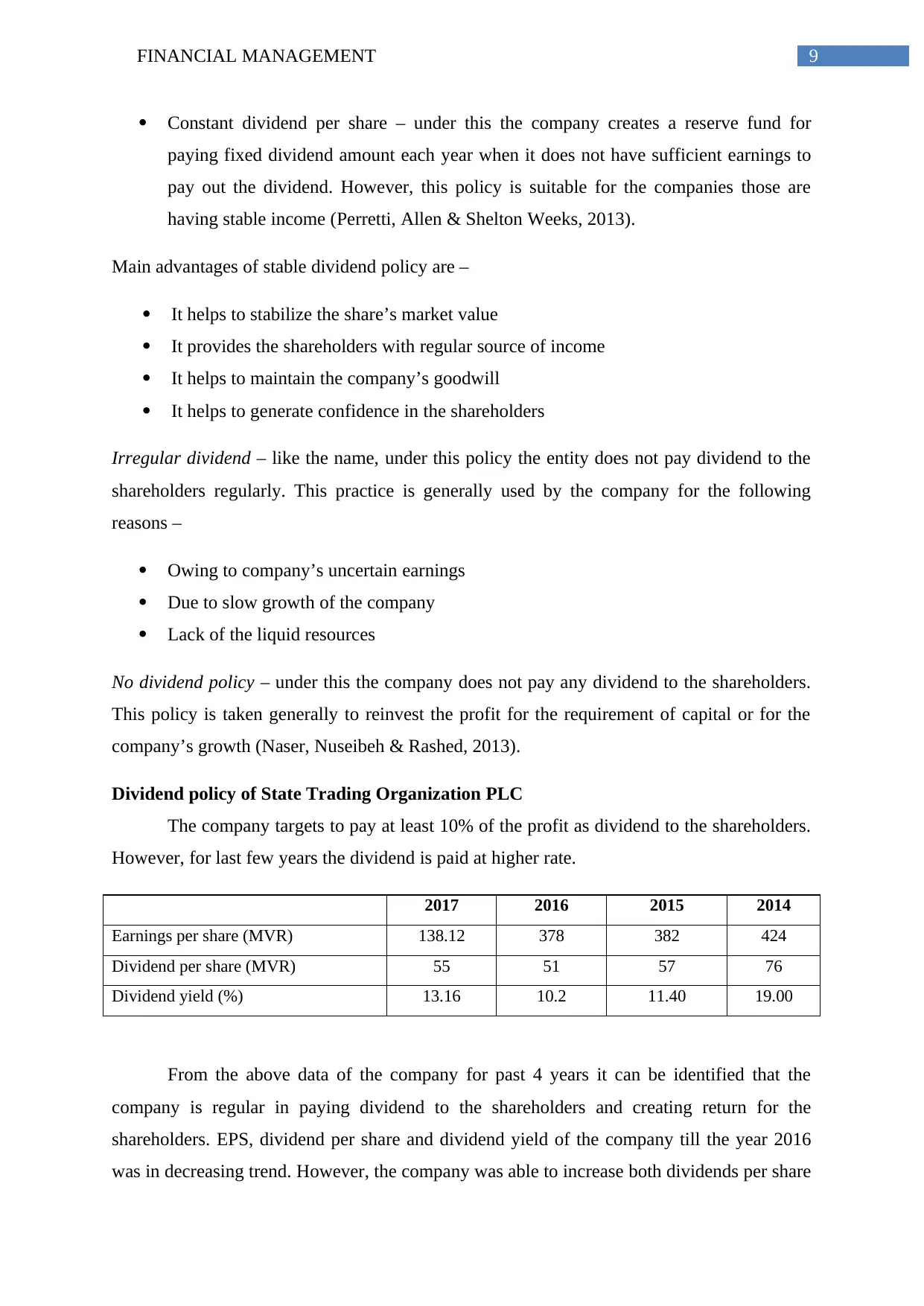
9FINANCIAL MANAGEMENT
Constant dividend per share – under this the company creates a reserve fund for
paying fixed dividend amount each year when it does not have sufficient earnings to
pay out the dividend. However, this policy is suitable for the companies those are
having stable income (Perretti, Allen & Shelton Weeks, 2013).
Main advantages of stable dividend policy are –
It helps to stabilize the share’s market value
It provides the shareholders with regular source of income
It helps to maintain the company’s goodwill
It helps to generate confidence in the shareholders
Irregular dividend – like the name, under this policy the entity does not pay dividend to the
shareholders regularly. This practice is generally used by the company for the following
reasons –
Owing to company’s uncertain earnings
Due to slow growth of the company
Lack of the liquid resources
No dividend policy – under this the company does not pay any dividend to the shareholders.
This policy is taken generally to reinvest the profit for the requirement of capital or for the
company’s growth (Naser, Nuseibeh & Rashed, 2013).
Dividend policy of State Trading Organization PLC
The company targets to pay at least 10% of the profit as dividend to the shareholders.
However, for last few years the dividend is paid at higher rate.
2017 2016 2015 2014
Earnings per share (MVR) 138.12 378 382 424
Dividend per share (MVR) 55 51 57 76
Dividend yield (%) 13.16 10.2 11.40 19.00
From the above data of the company for past 4 years it can be identified that the
company is regular in paying dividend to the shareholders and creating return for the
shareholders. EPS, dividend per share and dividend yield of the company till the year 2016
was in decreasing trend. However, the company was able to increase both dividends per share
Constant dividend per share – under this the company creates a reserve fund for
paying fixed dividend amount each year when it does not have sufficient earnings to
pay out the dividend. However, this policy is suitable for the companies those are
having stable income (Perretti, Allen & Shelton Weeks, 2013).
Main advantages of stable dividend policy are –
It helps to stabilize the share’s market value
It provides the shareholders with regular source of income
It helps to maintain the company’s goodwill
It helps to generate confidence in the shareholders
Irregular dividend – like the name, under this policy the entity does not pay dividend to the
shareholders regularly. This practice is generally used by the company for the following
reasons –
Owing to company’s uncertain earnings
Due to slow growth of the company
Lack of the liquid resources
No dividend policy – under this the company does not pay any dividend to the shareholders.
This policy is taken generally to reinvest the profit for the requirement of capital or for the
company’s growth (Naser, Nuseibeh & Rashed, 2013).
Dividend policy of State Trading Organization PLC
The company targets to pay at least 10% of the profit as dividend to the shareholders.
However, for last few years the dividend is paid at higher rate.
2017 2016 2015 2014
Earnings per share (MVR) 138.12 378 382 424
Dividend per share (MVR) 55 51 57 76
Dividend yield (%) 13.16 10.2 11.40 19.00
From the above data of the company for past 4 years it can be identified that the
company is regular in paying dividend to the shareholders and creating return for the
shareholders. EPS, dividend per share and dividend yield of the company till the year 2016
was in decreasing trend. However, the company was able to increase both dividends per share
Paraphrase This Document
Need a fresh take? Get an instant paraphrase of this document with our AI Paraphraser
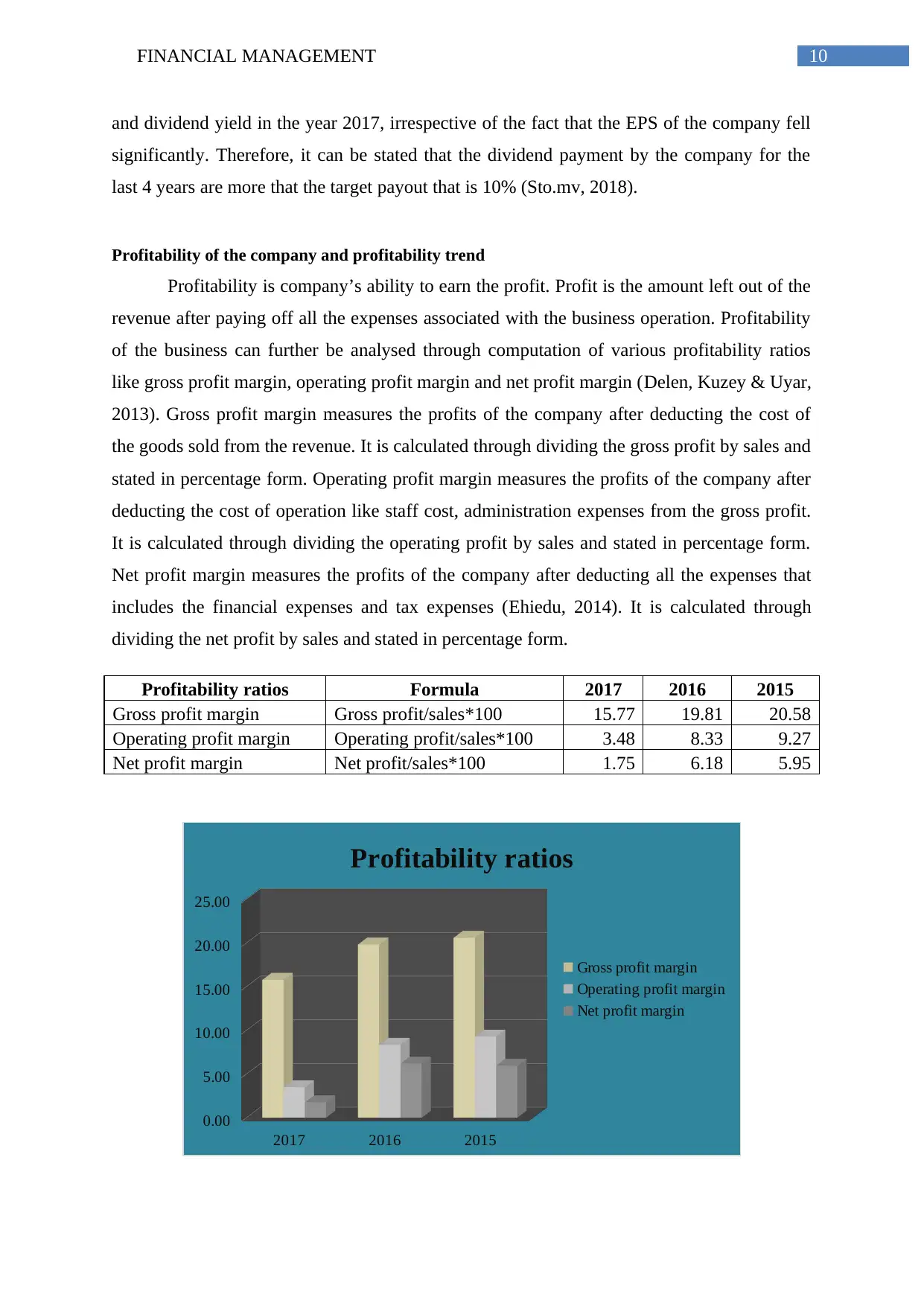
10FINANCIAL MANAGEMENT
and dividend yield in the year 2017, irrespective of the fact that the EPS of the company fell
significantly. Therefore, it can be stated that the dividend payment by the company for the
last 4 years are more that the target payout that is 10% (Sto.mv, 2018).
Profitability of the company and profitability trend
Profitability is company’s ability to earn the profit. Profit is the amount left out of the
revenue after paying off all the expenses associated with the business operation. Profitability
of the business can further be analysed through computation of various profitability ratios
like gross profit margin, operating profit margin and net profit margin (Delen, Kuzey & Uyar,
2013). Gross profit margin measures the profits of the company after deducting the cost of
the goods sold from the revenue. It is calculated through dividing the gross profit by sales and
stated in percentage form. Operating profit margin measures the profits of the company after
deducting the cost of operation like staff cost, administration expenses from the gross profit.
It is calculated through dividing the operating profit by sales and stated in percentage form.
Net profit margin measures the profits of the company after deducting all the expenses that
includes the financial expenses and tax expenses (Ehiedu, 2014). It is calculated through
dividing the net profit by sales and stated in percentage form.
Profitability ratios Formula 2017 2016 2015
Gross profit margin Gross profit/sales*100 15.77 19.81 20.58
Operating profit margin Operating profit/sales*100 3.48 8.33 9.27
Net profit margin Net profit/sales*100 1.75 6.18 5.95
2017 2016 2015
0.00
5.00
10.00
15.00
20.00
25.00
Profitability ratios
Gross profit margin
Operating profit margin
Net profit margin
and dividend yield in the year 2017, irrespective of the fact that the EPS of the company fell
significantly. Therefore, it can be stated that the dividend payment by the company for the
last 4 years are more that the target payout that is 10% (Sto.mv, 2018).
Profitability of the company and profitability trend
Profitability is company’s ability to earn the profit. Profit is the amount left out of the
revenue after paying off all the expenses associated with the business operation. Profitability
of the business can further be analysed through computation of various profitability ratios
like gross profit margin, operating profit margin and net profit margin (Delen, Kuzey & Uyar,
2013). Gross profit margin measures the profits of the company after deducting the cost of
the goods sold from the revenue. It is calculated through dividing the gross profit by sales and
stated in percentage form. Operating profit margin measures the profits of the company after
deducting the cost of operation like staff cost, administration expenses from the gross profit.
It is calculated through dividing the operating profit by sales and stated in percentage form.
Net profit margin measures the profits of the company after deducting all the expenses that
includes the financial expenses and tax expenses (Ehiedu, 2014). It is calculated through
dividing the net profit by sales and stated in percentage form.
Profitability ratios Formula 2017 2016 2015
Gross profit margin Gross profit/sales*100 15.77 19.81 20.58
Operating profit margin Operating profit/sales*100 3.48 8.33 9.27
Net profit margin Net profit/sales*100 1.75 6.18 5.95
2017 2016 2015
0.00
5.00
10.00
15.00
20.00
25.00
Profitability ratios
Gross profit margin
Operating profit margin
Net profit margin
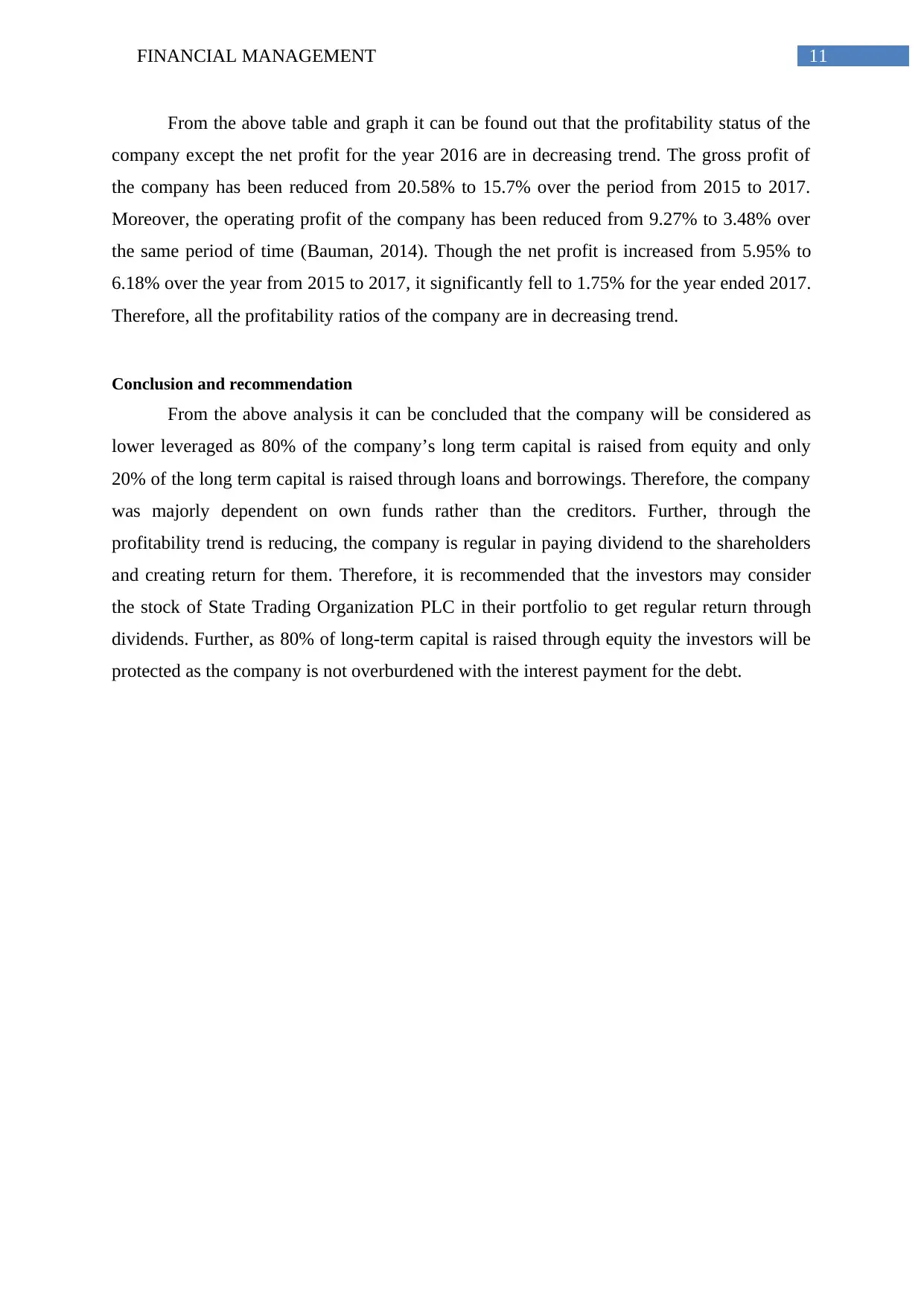
11FINANCIAL MANAGEMENT
From the above table and graph it can be found out that the profitability status of the
company except the net profit for the year 2016 are in decreasing trend. The gross profit of
the company has been reduced from 20.58% to 15.7% over the period from 2015 to 2017.
Moreover, the operating profit of the company has been reduced from 9.27% to 3.48% over
the same period of time (Bauman, 2014). Though the net profit is increased from 5.95% to
6.18% over the year from 2015 to 2017, it significantly fell to 1.75% for the year ended 2017.
Therefore, all the profitability ratios of the company are in decreasing trend.
Conclusion and recommendation
From the above analysis it can be concluded that the company will be considered as
lower leveraged as 80% of the company’s long term capital is raised from equity and only
20% of the long term capital is raised through loans and borrowings. Therefore, the company
was majorly dependent on own funds rather than the creditors. Further, through the
profitability trend is reducing, the company is regular in paying dividend to the shareholders
and creating return for them. Therefore, it is recommended that the investors may consider
the stock of State Trading Organization PLC in their portfolio to get regular return through
dividends. Further, as 80% of long-term capital is raised through equity the investors will be
protected as the company is not overburdened with the interest payment for the debt.
From the above table and graph it can be found out that the profitability status of the
company except the net profit for the year 2016 are in decreasing trend. The gross profit of
the company has been reduced from 20.58% to 15.7% over the period from 2015 to 2017.
Moreover, the operating profit of the company has been reduced from 9.27% to 3.48% over
the same period of time (Bauman, 2014). Though the net profit is increased from 5.95% to
6.18% over the year from 2015 to 2017, it significantly fell to 1.75% for the year ended 2017.
Therefore, all the profitability ratios of the company are in decreasing trend.
Conclusion and recommendation
From the above analysis it can be concluded that the company will be considered as
lower leveraged as 80% of the company’s long term capital is raised from equity and only
20% of the long term capital is raised through loans and borrowings. Therefore, the company
was majorly dependent on own funds rather than the creditors. Further, through the
profitability trend is reducing, the company is regular in paying dividend to the shareholders
and creating return for them. Therefore, it is recommended that the investors may consider
the stock of State Trading Organization PLC in their portfolio to get regular return through
dividends. Further, as 80% of long-term capital is raised through equity the investors will be
protected as the company is not overburdened with the interest payment for the debt.
⊘ This is a preview!⊘
Do you want full access?
Subscribe today to unlock all pages.

Trusted by 1+ million students worldwide
1 out of 14
Related Documents
Your All-in-One AI-Powered Toolkit for Academic Success.
+13062052269
info@desklib.com
Available 24*7 on WhatsApp / Email
![[object Object]](/_next/static/media/star-bottom.7253800d.svg)
Unlock your academic potential
Copyright © 2020–2025 A2Z Services. All Rights Reserved. Developed and managed by ZUCOL.





